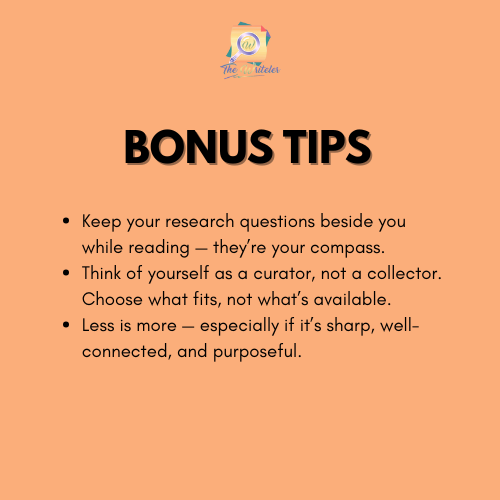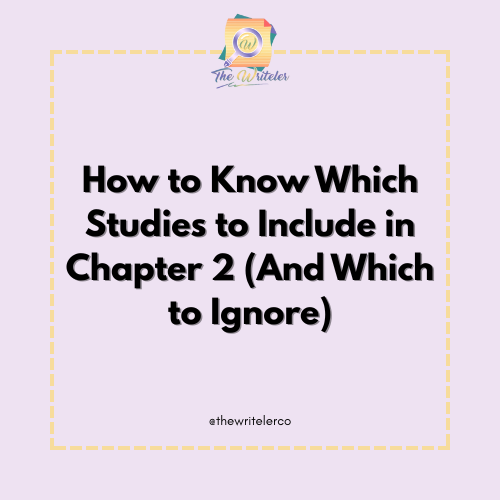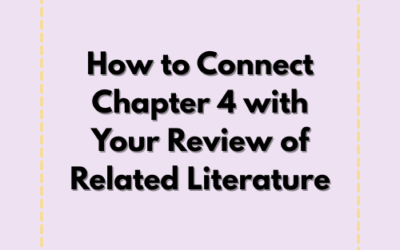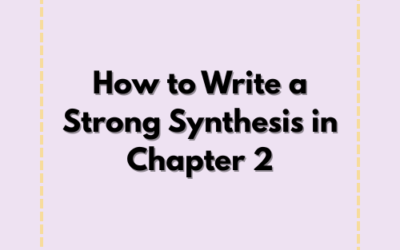You’re writing Chapter 2 — the literature review — and now you have a folder full of PDFs, 50 open tabs, and a growing sense of panic.
You’ve read dozens of articles, but the big question remains:
Which ones do you actually include?
It’s a common trap: feeling like you have to mention every study you found just to look thorough. But here’s the truth — a great literature review is not about volume, it’s about relevance and clarity.
In this guide, we’ll walk you through how to decide which studies to keep and which to toss — so you can write a strong, focused Chapter 2 that your panel will respect (and understand).]
The Real Purpose of Chapter 2
Before anything else, remember: Chapter 2 isn’t a dump of everything ever written on your topic.
It should:
- Establish the current state of knowledge in your field.
- Identify gaps in the literature.
- Position your study as a meaningful contribution.
So if a study doesn’t help you do that, it probably doesn’t belong in Chapter 2.
How to Know What to Include
Use this checklist to evaluate each study:
✅ 1. Is it relevant to your topic, variables, or research questions?
This is the most important filter. Ask:
- Does it support, contradict, or inform my research?
- Can I connect it to my objectives or framework?
If it’s only slightly related or talks about a different population/context altogether with no meaningful comparison — skip it.
✅ 2. Is it recent?
Most panels and journals prefer sources from the last 5–10 years. Exceptions:
- If the study is a foundational theory (e.g., Bandura, Vygotsky).
- If there are very few recent works on a niche topic.
Avoid relying heavily on outdated research — it weakens your credibility.
✅ 3. Is it from a credible source?
Look for:
- Peer-reviewed journals
- Academic books
- Theses/dissertations from reputable institutions
🚫 Avoid: blogs, opinion sites, or random PDFs from questionable domains.
✅ 4. Is it contextually similar?
Studies done in the same region, population, or setting as your own carry more weight.
But if a study is from a different country, ask:
- Can it offer contrast or highlight differences?
- Does it help justify why your local study is needed?
If not — don’t force it in.
✅ 5. Does it add unique insight?
Don’t repeat the same idea five times with different citations. Choose:
- The clearest
- The most well-designed
- Or the most cited/credible study
Focus on depth, not repetition.
When to Ignore a Study
Not everything you find belongs in Chapter 2. Exclude if:
🚫 It’s too old.
Unless it’s foundational, avoid relying on studies from 15–20 years ago.
🚫 It’s only slightly relevant.
If it mentions your keyword once but doesn’t explore it deeply, skip it.
🚫 It lacks credibility.
No author, no journal, no methodology? No thank you.
🚫 It adds nothing new.
If it just repeats findings you already covered in another source, let it go.
How Many Studies Should You Include?
This depends on your academic level:
- 📘 Undergrad thesis – 15–30 studies
- 📗 Master’s thesis – 30–60 studies
- 📕 Ph.D. dissertation – 60–100+ studies
But don’t aim for numbers. Aim for coverage. Each study should play a role in building your case.
How to Stay Organized
- Use a literature matrix or spreadsheet with columns:
Author | Year | Topic | Method | Key Findings | Relevance - Create folders by theme (e.g., Motivation, Learning Strategies, Stress Management).
- As you read, ask: “Where can I plug this into my outline?” If the answer is “nowhere,” set it aside.
Common Mistakes to Avoid
🚫 Including everything to make your chapter longer.
🚫 Copy-pasting summaries without synthesis.
🚫 Citing outdated or low-quality sources.
🚫 Judging by titles only. Read abstracts and conclusions at the very least.

📣 Overwhelmed by Chapter 2? We’ve Got You.
The Writeler Co. is here to support students and professionals who are juggling research with work, life, and business. Whether you’re writing a thesis, capstone, or dissertation for your master’s or Ph.D., we help you efficiently navigate the research journey — from brainstorming to proofreading.
📩 Message us today to get started.
📚 Let’s turn your research idea into a powerful paper.





0 Comments